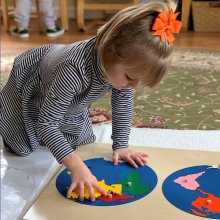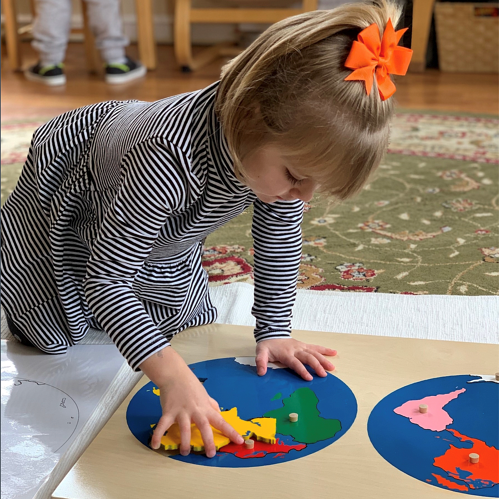
For those who are familiar with Montessori classrooms, one thing that generally stands out are the well-maintained, meticulously selected learning materials. Montessori education emphasizes hands-on, project-based learning that allows students to self-correct and try again until they achieve mastery. Using manipulatives like thermic tiles, counting beads, and movable maps allow students to scaffold their learning with concrete materials until they reach the point in each subject where they can work in abstraction.
- For example, different Montessori materials of increasing complexity lead students through a progression of building hand strength and dexterity; tracing letter and number shapes; and eventually writing the alphabet and numbers on their own. When a student can create letters and numbers with no physical aid, they have reached the stage of writing in abstraction. Of course, during this progression, other skills (such as reading and comprehension) are growing in concert. The Montessori framework weaves these physical, emotional, and psychological priorities into a comprehensive, hands-on curriculum.
- MONTESSORI MATERIALS ACROSS THE DISCIPLINES - Subject areas are seamlessly interwoven in a true Montessori classroom. Hands-on materials are used across a variety of subject areas, and often the same materials can be used for lessons that span a variety of classroom subjects. For example, an Early Childhood dexterity work might involve pouring water from one vessel to another, and these same vessels (and water) may be used to explore the differences between states of matter in a science experiment in the same classroom. Throughout the levels of a Montessori education, many of the materials will resemble those of the previous levels. Developing comfort, mastery, and a self-guided routine are hallmarks of learning in the Montessori environment. Having familiar, but increasingly complex, materials at hand helps students to move from the concrete to the abstract, without fear.
- INCREASING COMPLEXITY TOWARDS ABSTRACTION - For example, students work with maps, learning the composition and cultures of the world. In Early Childhood, students start by identifying land and water masses and tracing or coloring maps of the continents. As the student progresses through kindergarten, they move on to identifying continents, oceans, and countries using new map materials, like puzzle maps. By Upper Elementary, students are locating countries and capital cities on specially made maps, identifying geographic features, and eventually creating maps on their own, in the abstract.
- MATERIALS THAT GROW WITH THE STUDENT - Not only does the complexity of the work grow with the student, but the materials grow over time as well. In this way, students can rely on the routines they have established before, without hampering their progress toward mastering new skills. At the earliest stages, children begin by interacting with the Practical Life materials. These materials help develop the foundational skills needed to effectively utilize the Math, Language, and Sensorial materials later on.
MATH MATERIALS
From Early Childhood on, Montessori students interact with math manipulatives that help them learn what numbers are and how they interact with each other. There are many different math materials to choose from, but the most common materials, and the ones you see throughout multiple levels of Montessori learning, are the bead chain (bead cabinet), arithmetic boards or charts, and bead frames.
BEAD CHAINS - Bead chains are ubiquitous in the Montessori learning environment. Most classrooms are equipped with a bead cabinet, that holds a variety of beads and bead chains. These chains can be used in a number of lessons, building from counting and addition to complex algebra. Bead chains are particularly useful in learning the base-ten number system, and the relationships between numbers and their squares and cubes, for more advanced students.
ARITHMETIC BOARDS - Addition and multiplication boards serve many purposes in the process of learning arithmetic. These chart-like boards show the relationships between numbers, and mathematic operations, in a holistic, visible way. Working with these boards makes the "magic" of math more concrete, and helps students to recall sums and products of simple equations quickly.
BEAD FRAMES - The bead frame is a tool primarily used for exploring the use and power of the decimal place. The bead frame (similar to an abacus) allows students to explore the concepts of place value, decimal place, and numerical powers. Students are thrilled to learn that they can calculate complex equations with the use of the bead frame.
LANGUAGE MATERIALS
SANDPAPER LETTERS TO MOVABLE ALPHABETS
Language materials make up a large portion of the materials found in a Montessori classroom. Acquiring language is a key step in future learning.
Developing the skills needed to read and write is a massive undertaking. It begins with developing the most foundational skills; hand strength, coordination, and dexterity. It proceeds through the physical skills needed to write, and the psychological skills needed for reading comprehension and spelling.
- DEXTERITY MATERIALS - The youngest Montessori learners start their language journey by hearing others read to them, and by developing the dexterity and strength needed to begin learning to write. Students develop dexterity through a number of works and materials, including painting with watercolors, using scissors and silverware, and manipulating fasteners and locks. Materials like the dressing frame allow students to explore a number of different materials and movements so that they can refine their motor skills quickly.
- SANDPAPER LETTERS - From the earliest levels, students are introduced to letters and sounds, and begin differentiating between consonants, vowels, and key sounds that are not covered by single letters. Each letter of the alphabet is formed from sandpaper and mounted on a square tile. Consonants and vowels are mounted on different color tiles, and key sounds are mounted on a third. Students begin to internalize the shapes of the letters, the sounds, and the differences between the groups.
- MOVABLE ALPHABETS - The movable alphabet builds on the themes of the sandpaper letters. Multiple representations of each letter are stored for children to recognize from their earlier work, and piece together into words. The color coding of consonants and vowels remains, but the student is now required to combine the letters on their own to form words.
SENSORIAL MATERIALS
Central to a strong education is being able to understand and characterize sensory input. In the Early Childhood years, sensory materials are used to teach students how basic sensations feel, and the vocabulary to describe those feelings. Sensorial work gives young students the agency to not only choose their own work but to define their own experience. This is a hallmark of Montessori education and is crucial in developing the senses of curiosity and independence that will carry the student through their academic career.
- THE PINK TOWER - The Pink Tower is a fundamental Montessori manipulative, which serves many purposes. The tower is composed of a number of cube-shaped blocks, each smaller than the one on which it sits. The goal of tower work is to arrange the blocks properly, using coordination, order, and concentration to build the tower from bottom to top. This work teaches students to compare the features (sizes) of different shapes, arrange them in a logical order, and use dexterity to place the pieces correctly.
- PUZZLE MAPS - Puzzle maps, or movable maps, allow students to explore the location and orientation of continents on the globe. Students use their tactile senses to fit the pieces of the map together while using their visual sense to compare their map with a color-coded globe to make sure their pieces are in the right place. Students also practice identifying and naming the continents, and later the oceans and other land forms.
- THERMIC TILES - Thermic tiles or thermic tablets are pieces of material designed to help students refine their thermic sense; or their ability to feel and identify different levels of heat. These tiles are often made of various materials that conduct heat at different levels. Students use their thermic sense to arrange these tiles in relative order, from coldest to warmest, and refine their ability to feel and categorize the sensory input they are receiving.
.jpg&command_2=resize&height_2=85)
.jpg&command_2=resize&height_2=85)
















